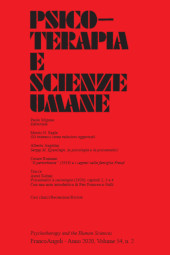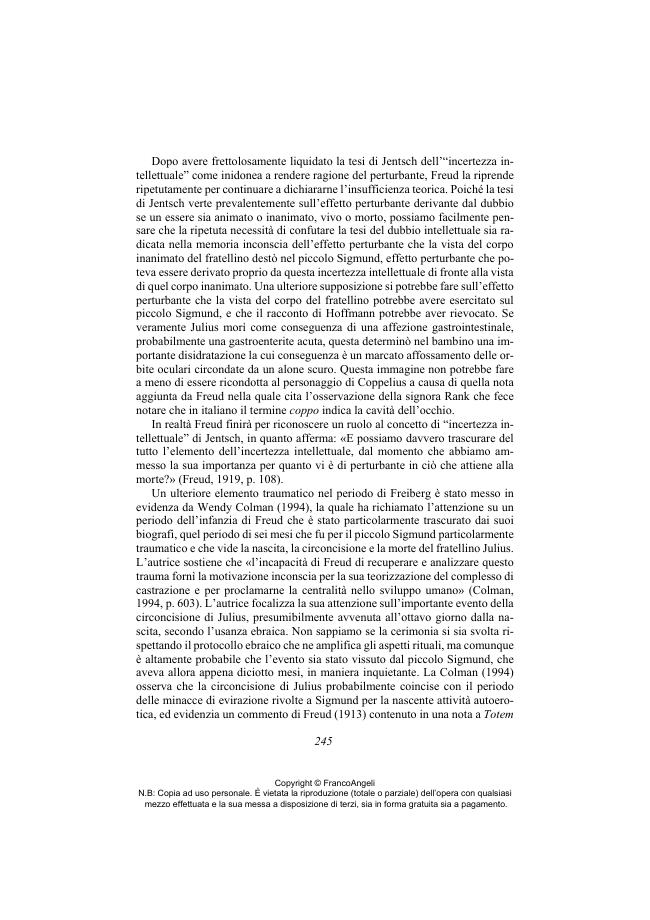Il perturbante (1919) e i segreti nella famiglia Freud
235-254 p.
Viene preso in considerazione lo scritto di Freud del 1919 Il perturbante, concepito in un momento di turbamento collegato al recente conflitto mondiale e da più autori considerato problematico e confuso. Il saggio di Freud ruota attorno all'interpretazione del racconto di Hoffmann del 1815 L'uomo della sabbia (Der Sandmann), che attraverso il ricorrente tema degli occhi egli riconduce al tema della castrazione. Tenendo presente la lettura che Gregorio Kohon (2016) ha fatto dell'esperienza estetica affermando che sia per lo scrittore-artista che per il lettore-spettatore sarà sempre autobiografica, e del saggio di Rand & Torok (1994) che individuano come fulcro del racconto il tema di un segreto famigliare, si argomenta che l'interesse di Freud per questo racconto poteva avere radici inconsce in alcuni segreti famigliari della sua infanzia che il bambino Sigmund non riuscì a svelare e che anche la lettura che Freud ne fece fu essenzialmente autobiografica.
Si individuano tre episodi infantili che potevano avere quel carattere perturbante di cui si parla nel saggio: la morte del fratellino Julius, l'avere assistito ripetutamente alla scena primaria, la scomparsa della bambinaia e la partenza da Freiberg. [Testo dell'editore].
Freud's 1919 paper The Uncanny, written during troubled times after First World War and often considered problematic and confused, is discussed. This paper deals with the interpretation of E.T.A. Hoffmann's 1815 novel Der Sandmann, where the recurrent reference to the eyes is brought back by Freud to the castration complex. Discussing Kohon's (2016) paper on aesthetic experiences where he states that (whether for the writer-artist or the reader-spectator) these expe-riences will always be autobiographical, and Rand & Torok (1994) for whom Hoffmann's novel has no reference to castration but to a family secret, it is argued that Freud's concern with this novel could be unconsciously rooted in some family secrets related to his childhood that the little Sigmund was not able to uncover. Freud must have read the novel Der Sandmann autobiograph-ically according to Kohon's theory.
In reference to Jentsch's (1906) paper "On the Psychology of the Uncanny", where the source of the uncanny is seen in the intellectual uncertainty whether an object is alive or not, it is argued that this statement could have brought back unconscious memo-ries of the brother Julius' death, from whom Freud would have protected himself moving to the castration topic. Some scholars found in Hoffmann's novel a hidden reference to the primal sce-ne, that is another uncanny background in Freud's childhood. Another uncanny episode occurred to the little Sigmund when he lost his beloved nanny. It is argued that these three topics where the unconscious factors that compelled Freud to write about the uncanny choosing Hoffmann's novel. [Publisher's text].
Fait partie de
Psicoterapia e scienze umane : LIV, 2, 2020-
Articles du même numéro (disponibles individuellement)
-
Informations
Code DOI : 10.3280/PU2020-002004
ISSN: 1972-5043
DISCIPLINES
KEYWORDS
- Perturbante, Hoffmann, Esperienza estetica, Infanzia di Freud, Ricordi traumatici
- Uncanny, Hoffmann, Aesthetic experience, Freud's childhood, Traumatic memories



